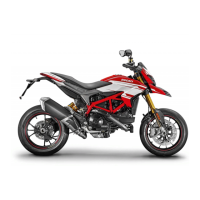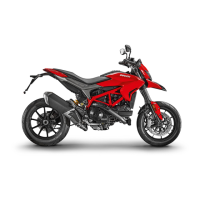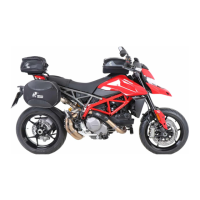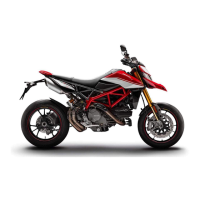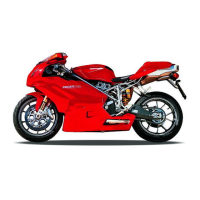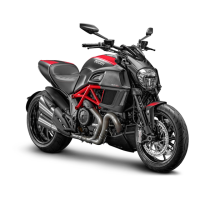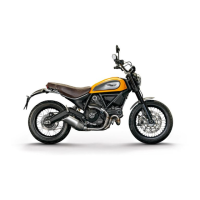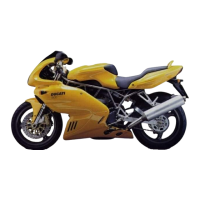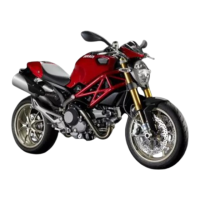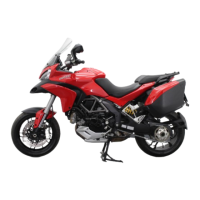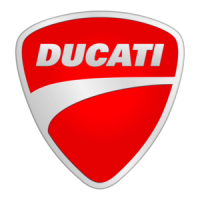
Do you have a question about the Ducati HyperMotard 698 MONO 2024 and is the answer not in the manual?
| Displacement | 659 cc |
|---|---|
| Max. Torque | 63 Nm (46.5 lb-ft) @ 8, 000 rpm |
| Frame | Steel trellis frame |
| Engine Type | Superquadro Mono |
| Max. Power | 77.5 hp (57 kW) @ 9, 750 rpm |
| Fuel Injection | Electronic fuel injection |
| Exhaust | Stainless steel muffler with catalytic converter and 2 lambda probes |
| Gearbox | 6-speed |
| Final Drive | Chain |
| Front Suspension | USD fork, fully adjustable |
| Rear Suspension | Monoshock, fully adjustable |
| Front Brake | Single Ø 330 mm aluminium flange disc, Brembo M4.32 4-piston radial caliper, ABS Cornering |
| Rear Brake | Ø 245 mm disc, 1-piston caliper, ABS Cornering |
| Wheels | Light alloy cast wheels, 3.5" x 17" / 5.0" x 17" |
| Front Tire | 120/70 ZR17 |
| Rear Tire | 160/60 ZR17 |
| Dry Weight | 151 kg |
| Safety Equipment | ABS, Ducati Traction Control (DTC), Riding Modes |
| Standard Equipment | LED lighting |
| Instrumentation | LCD display with gear indicator, fuel level, trip computer, and more |
Lists services provided, including towing, information, and transport.
Details on updates, safety, and conformity.
Covers warranty content, exclusions, and claiming procedures.
Ducati's liability limits and legal jurisdiction.
Steps to pair and manage Bluetooth devices.
Managing calls, call back, and call in progress features.
Activating, deactivating, and managing the music player.
Glossary of terms used in the manual.
Explanation of warning symbols and safety precautions.
Motorcycle's purpose, limitations, and rider responsibilities.
Recommended apparel and essential safety operations.
Instructions for refueling and warnings about dangerous products.
Guidelines for carrying luggage and passengers safely.
Identifies controls, switches, and their functions.
Operation of headlights, DRL, and turn indicators.
Information on keys, spare keys, and the anti-theft system.
Ignition, PIN code management, and operation restoration.
Operation and adjustment of clutch, throttle, brake, and gear pedals.
Initial break-in guidelines and essential pre-ride safety checks.
Explanation and checks for the Anti-Lock Braking System.
Steps for starting, stopping, and auto-shutdown features.
Instructions for starting movement, parking, and braking.
Instructions for refueling and understanding fuel recommendations.
Information on supplied tools and optional accessories.
Description of the display and its warning indicators.
Information on the main screen and navigation through menus.
Explains Riding Modes and how to customize parameters.
Adjusting traction, wheelie, ABS, quick shift, and engine braking controls.
Controlling heated grips and accessing the main settings menu.
Setting PIN, clock, date, and viewing service information.
Configuring indicators, units, tyre calibration, and battery voltage.
Using launch control and understanding display messages.
Procedure for checking and adding engine coolant safely.
How to check fluid levels in brake and clutch systems.
Inspecting brake pads for wear and replacement.
Steps for preparing, connecting, and charging the motorcycle battery.
Procedures for long-term storage and safe transportation.
Checking chain tension, lubrication, and headlight adjustment.
Tyre specifications, tread depth, and related information.
Procedure for checking engine oil and recommended oil types.
Safe methods for washing and cleaning the motorcycle.
Total weight, maximum load, and overall motorcycle dimensions.
Recommended fluids and their capacities for the motorcycle.
Details on engine, transmission, and suspension systems.
Tyre types, pressures, and electrical components.
Fuse box identification, ratings, and regulatory compliance.
List of maintenance tasks to be performed by authorized dealers.
List of maintenance tasks for the owner to perform.
Declarations of radio equipment compliance with EU directives.
Regulatory compliance statements for various countries and regions.
